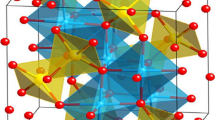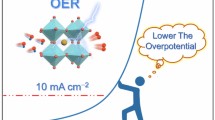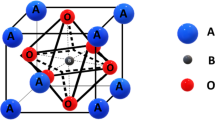Abstract
Doped metal oxide nanostructures have emerged as a subject of considerable interest in the domain of energy storage applications, owing to their exceptional characteristics in comparison to their pristine metal oxides. Herein, pristine and Tin (Sn) doped hematite (α-Fe2O3) nanostructures were successfully synthesized using the hydrothermal method. The effect of Sn doping on various characteristics of hematite nanoparticles, such as unit cell size, crystallinity, particle size, and electrochemical properties, was examined and analyzed. The verification of Sn4+ ions being integrated into the crystalline structure of hematite was established through X-ray photoelectron spectroscopy (XPS) and with the assessment of unit cell expansion resulting from the substitution of octahedrally coordinated Fe3+ ions, with notably larger Sn4+ ions. The electrochemical properties of the materials that were prepared were analyzed within a three-electrode cell setup, utilizing a 3.0 M aqueous potassium hydroxide electrolyte. Notably, the hematite electrode doped with 7% Tin exhibited exceptional capacitance, reaching a value of 833 F/g at a scan rate of 10 mV/s. The incorporation of Tin into the hematite structure played a critical role in facilitating efficient ion transport and enhancing conductivity, thus promoting favorable conditions for various electrochemical reactions. Furthermore, the material exhibits exceptional rate capability and robust cycling stability. Finally, an asymmetric supercapacitor was fabricated by integrating Sn-doped α-Fe2O3 as the anode material and activated carbon as the cathode material. The resultant device showcases impressive energy and power densities of 28.3 Wh Kg−1 and 528.8 W Kg−1, respectively. Such noteworthy performance characteristics signify its promising prospects for practical implementation in energy storage devices.















Similar content being viewed by others
References
Sun H, Mei L, Liang J, Zhao Z, Lee C, Fei H, Ding M, Lau J, Li M, Wang C et al (2017) Three-dimensional holeygraphene/niobia composite architectures for ultrahigh-rate energy storage. Science 356:599–604
Xiao X, Song H, Lin S, Zhou Y, Zhan X, Hu Z, Zhang Q, Sun J, Yang B, Li T et al (2016) Scalable salt-templated synthesis of two-dimensional transition metal oxides. Nat Commun 7:11296
Li S, Wang Y, Sun J, Zhang Y, Xu C, Chen H (2020) Hydrothermal synthesis of Fe-doped Co3O4 urchin-like microstructures with superior electrochemical performances. J Alloys Compd 821:153507
Ma P, Zhuang Z, Cao J, Ju B, Xi X (2022) ZnO–CoO composite nanosphere array-modified carbon cloth for low-voltage hysteresis Li metal Anodes. ACS Appl Energy Mater 5(5):6417–6422
Zhuang Z, Ju B, Ma P, Yang L, Tu F (2021) Ultrathin graphitic C 3 N 4 lithiophilic nanosheets regulating Li+ flux for lithium metal batteries. Ionics 27:1069–1079
Arico AS, Bruce P, Scrosati B, Tarascon JM, Van Schalkwijk W (2005) Nanostructured materials for advanced energy conversion and storage devices. Nat Mater 4:366–377
Manteghi F, Kazemi SH, Peyvandipour M, Asghari A (2015) Preparation and application of cobalt oxide nanostructures as electrode materials for electrochemical supercapacitors. RSC Adv 5:76458–76463
Asen P, Shahrokhian S, Iraji zad A (2018) Ternary nanostructures of Cr2O3/grapheneoxide/conducting polymers for supercapacitor application. J Electroanal Chem 823:505516
Khamlich S, Abdullaeva Z, Kennedy JV, Maazaa M (2017) High performance symmetric supercapacitor based on zinc hydroxychloride nanosheets and 3D graphene-nickel foam composite. Appl Surf Sci 405:329–336
Kaviyarasu K, Manikandan E, Kennedy J, Jayachandran M, Ladchumananandasiivam R, UmbelinoDe Gomes U, Maazaa M (2016) Synthesis and characterization studies of NiO nanorods for enhancing solar cell efficiency using photon up conversion materials. Ceram Inter 42:8385–8394
Balaji SS, Sathish M (2014) Supercritical fluid processing of nitric acid treated nitrogen doped graphene with enhanced electrochemical supercapacitance. RSC Adv 4:52256–52262
Amutha B, Sathish M (2015) A 2V Asymmetric supercapacitor based on reduced grapheneoxide-carbon nanofiber-manganese carbonate nanocomposite and reduced graphene oxide in aqueous solution. J Solid State Electrochem 19:2311–2320
Ullah E, Shah MZU, Ahmad SA, Sajjad M, Khan S, Alzahrani FM, and Guo S (2023) Hydrothermal assisted synthesis of hierarchical SnO2 micro flowers with CdO nanoparticles based membrane for energy astorage applications. Chemosphere 321:138004
Zheng H, Zhai T, Yu M, Xie S, Liang C, Zhao W, and Lu, X (2013) TiO2@ C core–shell nanowires for high-performance and flexible solid-state supercapacitors. J Mater Chem C 1(2):225–229
Akkinepally B, Reddy IN, Lee C, Ko TJ, Rao PS, Shim J (2023) Promising electrode material of Fe3O4 nanoparticles decorated on V2O5 nanobelts for high-performance symmetric supercapacitors. Ceram Int 49(4):6280–6288
Zhu Y, Cheng S, Zhou W, Jia J, Yang L, Yao M, Wang M, Zhou J, Wu P, Liu M (2017) Construction and performance characterization of α-Fe2O3/RGO composite for long-cycling-life supercapacitor anode. ACS Sustain Chem Eng 5:5067–5074
Zheng J, Cygan P, Jow T (1995) Hydrous ruthenium oxide as an electrode material for electrochemical capacitors. J Electrochem Soc 142(8):2699–2703
Huang J, Yang S, Xu Y, Zhou X, Jiang X, Shi N, and Wang, G (2014) Fe2O3 sheets grown on nickel foam as electrode material for electrochemical capacitors. J Electroanalyt Chem 713:98–102
Kadam SA, Ma YR, Chen YR, Navale YH, Salunkhe AS, Patil VB, and More PD (2023) Mn-incorporated α-Fe2O3 nanostructured thin films: facile synthesis and application as a high-performance supercapacitor. J Electron Mater 52(1):500–513
Lee S, Kim H, Jung HM (2016) Interfacial generation of plates assembled with α-Fe2O3 nano-flakes for electrochemical capacitors. J Electroanal Chem 770:44–49
Xie K, Li J, Lai Y, Lu W, Liu Y, Zhou L, Huang H (2011) Highly ordered iron oxide nanotube arrays as electrodes for electrochemical energy storage. Electrochem Commun 13(6):657–660
Hallam PM, Gomez-Mingot M, Kampouris DK, Banks CE (2012) Facile synthetic fabrication of iron oxide particles and novel hydrogen superoxide supercapacitors. RSC Adv 2(16):6672–6679. https://doi.org/10.1039/c2ra01139e
Chaudhari S, Bhattacharjya D, Yu J-S (2013) 1-Dimensional porous _-Fe2O3 nanorods as high-performance electrode material for supercapacitors. RSC Adv 3:25120–25128
Khan A, Shkir M, Ashraf IM, el-Toni AM, Aldalbahi A, AlFaify S (2020) One-step straightforward synthesis of Tb-doped NiO nanocomposites using flash combustion method: structural, optical, luminescent, and electrical switching properties. CeramInt 46:10678–10690
Dong Y, Zhao J, Zhang JY et al (2020) Synergy of Mn and Ni enhanced catalytic performance for toluene combustion over Ni-doped α-MnO2 catalysts. Chem Eng J 388:124244
Dong C, Qu Z, Jiang X, Ren Y (2020) Tuning oxygen vacancy concentration of MnO2 through metal doping for improved toluene oxidation. J Hazard Mater 391:122181
Shannon RD (1976) Revised effective ionic radii and systematic studies of interatomic distances in halides and chalcogenides. Acta Cryst A32:751–767. https://doi.org/10.1107/S0567739476001551
Zhuang Z, Yang L, Ju B, Yin A, Lei G, Zhou Q, and Qin S (2020) Engineering LiNi0. 5Co0. 2Mn0. 3O2/poly (propylene carbonate) interface by graphene oxide modification for all‐solid‐state lithium batteries. Energy Storage 2(2):e109
Ling Y, Li Y (2014) Review of Sn-doped hematite nanostructures for photoelectrochemical water splitting. Part Part Syst Charact 31(11):1113–1121
Ling Y, Wang G, Wheeler DA, Zhang JZ, Li Y (2011) Sn-doped hematite nanostructures for photoelectrochemical water splitting. Nano Lett 11(5):2119–2125
Popov N, Ristić M, Bošković M, Perović M, Musić S, Stanković D, Krehula S (2022) Influence of Sn doping on the structural, magnetic, optical and photocatalytic properties of hematite (α-Fe2O3) nanoparticles. J Phys Chem Solids 161:110372
Liu S, Yao K, Fu L, Ma M (2016) Selective synthesis of Fe3O4, γ-Fe2O3, and α -Fe2O3 using cellulose-based composites as precursors. RSC Adv 6:2135–2140
Soares PIP, Alves AMR, Pereira LCJ, Coutinho JT, Ferreira IMM, Novo CMM, Borges JPMR (2014) Effects of surfactants on the magnetic properties of iron oxide colloids. J Colloid Interface Sci 419:46–51
Fu YP, Lin CH, Hsu CS (2005) Preparation of ultrafine CeO2, powders by microwave-induced combustion and precipitation. J Alloys Compd 391:110–114
Justus JS, Dharma Roy SD, Ezhil Raj AM (2016) Influence of lanthanum doping on the structural and optical properties of hematite nanopowders. J Appl Sci Eng Methodol 2:272–277
Yamashita T, Hayes P (2008) Analysis of XPS spectra of Fe2+ and Fe3+ ions in oxide materials. Appl Surf Sci 254(8):2441–2449
Zhang Z, Hossain MF, Takahashi T (2010) Self-assembled hematite (α-Fe2O3) nanotube arrays for photo electrocatalytic degradation of azo dye under simulated solar light irradiation. Appl Catal B 95(3–4):423–429
Song S, Kim J, Lee D, Lee J, Min T, Chae JA, and Park S (2017) The effect of Fe2+ state in electrical property variations of Sn‐doped hematite powders. J Am Ceram Soc 100(9):3928–3934
Song H, Zhang L, He C, Qu Y, Tian Y, Lv Y (2011) Graphene sheets decorated with SnO2 nanoparticles: in situ synthesis and highly efficient materials for cataluminescence gas sensors. J Mater Chem 21(16):5972–5977
Hahn NT, Mullins CB (2010) Photoelectrochemical performance of nanostructured ti- and Sn-doped α-Fe2O3 photoanodes. Chem Mater 22:6474
Cai J, Kong L, Liu C, Du X, Xie Q, Li H, and Li S (2021) Solar energy protects steels against corrosion: advancing Sn doped hematite as photoanode. Surf Coat Technol 427:127838
Chen Z, Cvelbar U, Mozetič M, He J, Sunkara MK (2008) Long-range ordering of oxygen-vacancy planes in α-Fe2O3 nanowires and nanobelts. Chem Mater 20:3224–3228
Zhou Z, Wu S, Qin L, Li L, Li L, Li X (2018) Modulating oxygen vacancies in Sn-doped hematite film grown on silicon microwires for photoelectrochemical water oxidation. J Mater Chem A 6(32):15593–15602
Gawali SR, Dubal DP, Deonikar VG, Patil SS, Patil SD, Gomez‐Romero P, and Pant J (2016) Asymmetric supercapacitor based on nanostructured Ce‐doped NiO (Ce: NiO) as positive and reduced graphene oxide (rGO) as negative electrode. ChemistrySelect 1(13):3471–3478
Aalim M, Irshad I, Tantray AM, Sohail A, Want B, Shah MA (2023) Effect of chromium (Cr)-doping on electrochemical performance of microwave synthesized hematite (α-CrxFe2−xO3) nanosheets for supercapacitor application. J Mater Sci: Mater Electron 34(18):1409
Rohit RC, Jenifer A, Jagadale AD, Kumbhar VS, Lee H, Lee K (2020) Facile synthesis of Ce-doped α-cobalt hydroxide nanoflakes battery type electrode with an enhanced capacitive contribution for asymmetric supercapacitors. J Energy Storage 28:101227
Aalim M, Shah MA (2023) Role of oxygen vacancies and porosity in enhancing the electrochemical properties of microwave synthesized hematite (α-Fe2O3) nanostructures for supercapacitor application. Vacuum 210:111903
Zhang M, Chen K, Chen X, Peng X, Sun X, Xue D (2015) Ethylenediamine-assisted crystallization of Fe 2 O 3 microspindles with controllable size and their pseudocapacitance performance. CrystEngComm 17(7):1521–1525
Shivakumara S, Penki TR, Munichandraiah N (2014) High specific surface area α-Fe2O3 nanostructures as high-performance electrode material for supercapacitors. Mater Lett 131:100–103
Liu T, Ling Y, Yang Y, Finn L, Collazo E, Zhai T, and Li Y (2015) Investigation of hematite nanorod–nanoflake morphological transformation and the application of ultrathin nanoflakes for electrochemical devices. Nano Energy 12:169–177
Zhang Z, Wang H, Zhang Y, Mu X, Huang B, Du J, and Xie E (2017) Carbon nanotube/hematite core/shell nanowires on carbon cloth for supercapacitor anode with ultrahigh specific capacitance and superb cycling stability. Chem Eng J 325:221–228
Zhu L, Chang Z, Wang Y, Chen B, Zhu Y, Tang W, Wu Y (2015) Core–shell MnO 2@ Fe 2 O 3 nanospindles as a positive electrode for aqueous supercapacitors. J Mater Chem A 3(44):22066–22072
Xia X, Hao Q, Lei W, Wang W, Sun D, Wang X (2012) Nanostructured ternary composites of graphene/Fe 2 O 3/polyaniline for high-performance supercapacitors. J Mater Chem 22(33):16844–16850
Zhuang Z, Zhang F, Zhou Y, Niu Y, Yan Y, Tan DQ (2022) Brittle star-like nanoweb modified carbon cloth synthesized by self-templated hollow zeolitic imidazolate framework-8 for stable Li metal anodes. Mater Today Energy 30:101192
Patil SJ, Kumbhar VS, Patil BH, Bulakhe RN, Lokhande CD (2014) Chemical synthesis of α-La2S3 thin film as an advanced electrode material for supercapacitor application. J Alloy Comp 611:191–196
Li YH, Huang KL, Yao ZF, Liu SQ, Qing XX (2011) Co3O4 thin film prepared by a chemical bath deposition for electrochemical capacitors. Electrochim Acta 56:2140–2144
Zhang S, Yin B, Wang Z, Peter F (2016) Super long-life all solid-state asymmetric supercapacitor based on NiO nanosheets and α-Fe2O3 nanorods. Chem Eng J 306:193–203
Kim G, Kang J, Choe G, Yim S (2017) Enhanced energy density of supercapacitors using hybrid electrodes based on Fe2O3 and MnO2 nanoparticles. Int J Electrochem Sci 12:10015–10022
Singh AK, Mandal K (2015) Engineering of high-performance supercapacitor electrode based on Fe-Ni/Fe2O3-NiO core/shell hybrid nanostructures. J Appl Phys 117(10):105101
Acknowledgements
The authors express their gratitude to the Department of Science and Technology, New Delhi, for providing financial assistance in setting up the Special Laboratory for Multifunctional Nanomaterials. Additionally, they would like to thank the Ministry of Education for granting the fellowship.
Author information
Authors and Affiliations
Contributions
Malik Aalim, Aamir Sohail, Adfar Rashid, Arshid Mir, Ummer Altaf, and Reyaz Ahmad: conceptualization, methodology, data curation, and writing original draft. M.A. Shah: writing—review, editing validation, and supervision.
Corresponding authors
Ethics declarations
Conflict of interest
The authors declare no conflict of interests.
Additional information
Publisher's Note
Springer Nature remains neutral with regard to jurisdictional claims in published maps and institutional affiliations.
Rights and permissions
Springer Nature or its licensor (e.g. a society or other partner) holds exclusive rights to this article under a publishing agreement with the author(s) or other rightsholder(s); author self-archiving of the accepted manuscript version of this article is solely governed by the terms of such publishing agreement and applicable law.
About this article
Cite this article
Aalim, M., Altaf, U., Rashid, A. et al. Tin (Sn)-doped hematite (α-SnxFe2-xO3) nanostructures as high-performance electrodes for supercapacitor application. J Solid State Electrochem 28, 1–18 (2024). https://doi.org/10.1007/s10008-023-05651-2
Received:
Revised:
Accepted:
Published:
Issue Date:
DOI: https://doi.org/10.1007/s10008-023-05651-2




